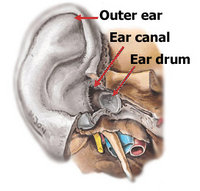 Nearly 30 million Americans have impaired hearing. The most common cause of hearing loss in children is otitis media. For the elderly-the largest group affected-excessive noise, drugs, toxins, and heredity are the most frequent contributing factors. Because many hearing problems can be medically corrected, it is especially important that you see an otolaryngologist. Patients with ear pain, drainage, excessive earwax, hearing loss in only one ear, sudden or rapidly progressive hearing loss, or dizziness should be evaluated immediately. It is always surprising to me how stoic people are in regard to their hearing loss. Certainly if someone were to lose their sight in such a fashion they would make their way immediately to the emergency room.
Nearly 30 million Americans have impaired hearing. The most common cause of hearing loss in children is otitis media. For the elderly-the largest group affected-excessive noise, drugs, toxins, and heredity are the most frequent contributing factors. Because many hearing problems can be medically corrected, it is especially important that you see an otolaryngologist. Patients with ear pain, drainage, excessive earwax, hearing loss in only one ear, sudden or rapidly progressive hearing loss, or dizziness should be evaluated immediately. It is always surprising to me how stoic people are in regard to their hearing loss. Certainly if someone were to lose their sight in such a fashion they would make their way immediately to the emergency room.
The ear has three main parts: the outer, middle and inner ear. The outer ear (the part you can see) opens into the ear canal. The eardrum separates the ear canal from the middle ear. Small bones in the middle ear help transfer sound to the inner ear. The inner ear contains the auditory (hearing) nerve, which leads to the brain. Any source of sound sends vibrations or sound waves into the air. These funnel through the ear opening, down the ear canal and strike your eardrum, causing it to vibrate. The vibrations are passed to the small bones of the middle ear, which transmit them to the hearing nerve in the inner ear. Here, the vibrations become nerve impulses and go directly to the brain, which interprets the impulses as sound (music, voice, a car horn, etc.).
The evaluation begins with a formal hearing assessment from an audiologist (a master’s level health care professional fully trained in hearing). A screening test from a hearing aid dealer is not adequate. The audiologist will assess your ability to hear pure tone sounds and to understand words and measure the compliance of the eardrum. The results of these tests will show the degree of hearing loss and whether it is conductive or sensorineural and may give other medical information about your ears and your health.
· Conductive Hearing Loss
A hearing loss is conductive when there is a problem with the ear canal, the eardrum and/or the three bones connected to the eardrum. Common reasons for this type of hearing loss are a plug of excess wax in the ear canal or fluid behind the eardrum. Medical treatment or surgery may be available for these and more complex forms of conductive hearing loss.
· Sensorineural Hearing Loss
A hearing loss is sensorineural when it results from damage to the inner ear (cochlea) or auditory nerve, often as a result of the aging process and/or noise exposure. Sounds may be unclear and/or too soft. Sensitivity to loud sounds may occur. Medical or surgical intervention cannot correct most sensorineural hearing losses. However, hearing aids may help you reclaim some sounds that you are missing as a result of nerve deafness.
After the physician gets the information from the history, physical exam, and audiological assessment he or she will be able to begin treatment. In some instances the patient will have a rapid or one-sided sensorineural hearing loss that requires further testing. Often an MRI scan, as well as some laboratory tests, will be obtained to rule out any infections or benign tumors in the region. If balance problems coexist the physician may also request a test to evaluate the balance system.
In summary, hearing loss is a serious medical disorder. In a limited number of patients, it can be surgically corrected. Otherwise prompt medical treatment and rehabilitation can substantially reduce hearing loss in the vast majority of patients who cannot be helped by surgery. I will begin aggressive treatment immediately, quickly secure the diagnosis, and follow the patient’s progress closely along with the audiologist.